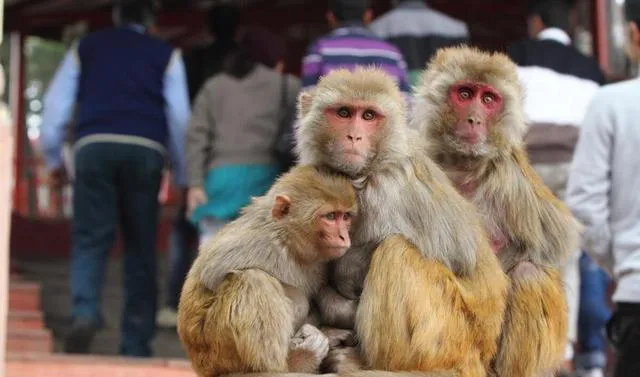Nature丨News丨Miryam Naddaf
16 Jan. 2024丨820words丨★★★☆☆
Cloned rhesus monkey lives to adulthood for first time
複制獼猴首次活到成年
A method that provides cloned embryos with a healthy placenta could pave the way for more research involving the primates.
一種為複制胚胎提供健康胎盤的方法可為更多涉及靈長類動物的研究鋪平道路。
Getty Image
For the first time, a rhesus monkey ( Macaca mulatta ) cloned in the laboratory has lived into adulthood — surviving for more than two years so far.
實驗室複制的獼猴(恒河猴[一種獼猴,多用於實驗])第一次活到了成年——迄今已存活兩年多。
獼猴(恒河猴)的成年階段 一般指雌性個體在4到5歲之間,而雄性個體則在5到6歲之間。這是它們達到生殖成熟並具備完全成熟的身體和行為特征的階段。
The feat, described today in Nature Communications [1], marks the first successful cloning of the species, and was achieved using a slightly different approach to the conventional cloning technique used to clone Dolly the sheep and other mammals, including long-tailed macaques ( Macaca fascicularis ), which were the first primates to be cloned.
今天發表在【自然通訊】上的這一壯舉標誌著該物種的首次成功複制,它采用的方法與用於複制羊「多利」和其他哺乳動物(包括長尾獼猴)的傳統複制技術略有不同,先前,長尾獼猴是第一種被複制的靈長類動物。
By replacing the placenta of the cloned embryo with a placenta from embryos produced by in-vitro fertilisation, scientists were able to reduce developmental defects that often hinder the survival of cloned embryos, while using fewer embryos and surrogate mothers. The new technique could unlock possibilities for using cloned primates in drug testing and behavioural research.
透過用體外受精產生的胚胎胎盤替代複制胚胎的胎盤,科學家們能夠減少經常阻礙複制胚胎存活的發育缺陷,同時使用更少的胚胎和代孕母親。這項新技術將為利用複制靈長類動物進行藥物測試和行為研究提供可能。
「We can produce a large number of genetically uniform monkeys that can be used for drug efficacy tests,」 says Mu-ming Poo, director of the Institute of Neuroscience in the Chinese Academy of Sciences in Shanghai.
中國科學院上海神經科學研究所所長蒲慕明說:"我們可以培育出大量基因一致的猴子,用於藥物療效測試。

Low survival rate
The standard cloning technique known as somatic cell nuclear transfer (SCNT) — where the nucleus of a body cell is transferred into an egg cell whose nucleus has been removed — typically results in extremely low birth and survival rates for cloned embryos.Success in primates has been particularly limited.
存活率低
體細胞核移植(SCNT)是一種標準的複制技術,即把體細胞核移植到去除了細胞核的卵細胞中,這種技術通常導致複制胚胎的出生率和存活率極低。在靈長類動物中,成功率尤其有限。
When researchers cloned long-tailed macaques in 2018, they created 109 cloned embryos, and implanted nearly three-quarters of them into 21 surrogate monkeys which resulted in six pregnancies. Just two of the monkeys survived birth.
研究人員在2018年複制長尾獼猴時,創造了109個複制胚胎,並將其中近四分之三植入21只代孕猴體內,結果有6只猴子懷孕。其中只有2只猴子存活下來。
In 2022, researchers cloned a rhesus monkey using SCNT, but the animal survived for less than 12 hours[2].
2022 年,研究人員利用 SCNT技術複制了一只獼猴,但該動物存活不到 12 小時。
To investigate what goes wrong in the cloning process, researchers at the Chinese Academy of Sciences in Shanghai compared 484 SCNT rhesus embryos with 499 embryos produced by conventional in-vitro fertilisation. The two types of embryos showed similar development before they were implanted into surrogates. But the number of cloned embryos that were successfully implanted was around half that of IVF embryos (35 vs. 74), and fewer cloned embryos survived to term.
為了研究複制過程中的問題所在,上海中國科學院的研究人員將 484 個 SCNT 獼猴胚胎與 499 個常規體外受精產生的胚胎進行了比較。兩種胚胎在植入代孕母猴體內前的發育情況相似。但成功植入的複制胚胎數量約為體外受精胚胎的一半(35 vs. 74),而且存活至出生的複制胚胎數量較少。
The researchers ran a series of DNA analyses of SCNT embryos and found significant differences in epigenetic modification during development — structural changes that impact gene activity without altering the DNA sequence. This included reduced DNA methylation, a process that affects genes expression. 「If you have different methylation, then the gene expression during development is different,」 explains Poo. 「That’s why cloned embryo does not develop well.」
研究人員對 SCNT 胚胎進行了一系列 DNA 分析發現:發育過程中的表觀遺傳修飾存在顯著差異,即在不改變 DNA 序列的情況下影響基因活性的結構變化。這包括 DNA 甲基化的減少,這是一個影響基因表現的過程。蒲慕明解釋說:"如果甲基化程度不同,那麽基因在發育過程中的表達就會不同。這就是為什麽複制胚胎發育不良的原因"。
The researchers also found that genes which are normally expressed differently between maternal and paternal genomes, lost their distinct patterns in cloned embryos, especially in cells within the placenta. Furthermore, the placentas that developed for SCNT embryos appeared to be thicker than normal and contained defects.
研究人員還發現,在複制胚胎中,母基因組和父基因組通常以不同方式表達的基因失去了其獨特的模式,尤其是在胎盤內的細胞中。此外,SCNT 胚胎發育出的胎盤似乎比正常胎盤厚,而且存在缺陷。
To address this, the researchers developed a technique that involved replacing the SCNT trophoblast — the outer layer of cells in a developing embryo, which later forms the major part of the placenta — with trophoblasts from IVF embryos. This meant the embryos developed a 「natural placenta」, says study coauthor Zhen Liu, a neuroscientist at the Chinese Academy of Sciences, 「but the fetus is still cloned fetus」.
為了解決這個問題,研究人員開發了一種技術,即用體外受精胚胎的滋養層(胚胎發育過程中的外層細胞,後來形成胎盤的主要部份)替代體細胞核移植的滋養層。這項研究的共同作者、中國科學院神經科學家劉震說:"這意味著胚胎會發育出一個'自然胎盤',但胎兒仍然是複制胎兒"。

One healthy clone
Using this approach, the researchers created 113 cloned rhesus monkey embryos and implanted 11 of them into seven surrogates which resulted in two pregnancies.
一個健康的複制體
透過這種方法,研究人員創造了 113 個複制獼猴胚胎,並將其中 11 個植入 7 只代孕母猴體內,最終導致兩只代孕母猴懷孕成功。
One of the pregnant surrogates gave birth to a healthy male rhesus monkey named ReTro, which has survived for more than two years. (The other surrogate carried twins, which died on day 106 of gestation).
其中一只代孕母猴順利分娩出了一只健康的複制雄性獼猴,取名 ReTro,它已經存活了兩年多。(另一只代孕母猴懷的是一對雙胞胎,在妊娠第 106 天死亡了)。
The researchers showed that incorporating the trophoblast replacement into SCNT clones reduced defects in the placenta and in DNA methylation. But 「the efficiency of the process is similar, even lower」, than SCNT, said Lluís Montoliu, a geneticist at the Spanish National Center for Biotechnology in Madrid, in a statement to the UK Science Media Centre. 「It is extremely difficult to succeed with these experiments, with such low efficiencies,」 he added.
研究人員發現,將滋養層細胞置換技術套用於SCNT複制中,可減少胎盤缺陷和DNA甲基化問題。但是,馬德裏西班牙國家生物技術中心的遺傳學家路易斯-蒙托柳(Lluís Montoliu)在向英國科學媒體中心發表的一份聲明中表示,"這一過程的效率與SCNT相似,甚至更低"。他補充說:"在效率如此低的情況下,這些實驗很難取得成功。
Since the first primate was cloned six years ago, scientists have used cloned monkeys to model diseases such as depression and anxiety[3], and to assess the efficacy and safety of drugs, including antidepressants.
自從六年前複制出第一只靈長類動物以來,科學家們已經利用複制猴建立了抑郁癥和焦慮癥等疾病的模型 ,並評估了包括抗抑郁藥在內的藥物的療效和安全性。
「We're seeing the beginning of the use of these cloned monkeys now,」 says Poo. 「We want to use as few animals as possible to show drug efficacy, without the interference of genetic background.」 But he adds that with current technology, the process of producing clones still involves too many surrogates. Even with recent advances, 「we have not solved the efficiency of cloning」, he says.
蒲慕明教授說:「我們現在已經開始使用這些複制猴了,我們希望在不受遺傳背景幹擾的情況下,使用盡可能少的動物來展示藥物療效」。但他補充說,就目前的技術而言,生產複制猴的過程仍然涉及到太多的代用品。即使最近取得了進步,"我們也沒有解決複制的效率問題"。
doi: https://doi.org/10.1038/d41586-024-00136-2
References
- Zhaodi, L. et al. Nat. Commun. 15:5 https://doi.org/10.1038/s41467-023-43985-7 (2024).
- Kang, Y. et al. Sci. Adv. 8, eabo3123 https://www.science.org/doi/10.1126/sciadv.abo3123 (2022).
- Qiu, P. et al. National Science Review 6 (1), 87 https://doi.org/10.1093/nsr/nwz002 (2019).
英文取自Nature【自然】官網,轉譯&精讀內容歸本人所有,轉載請註明出處,違者必究!更多內容,請前往官網學習。
原文地址:303 See Other











